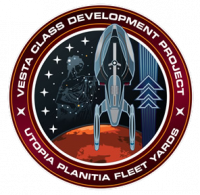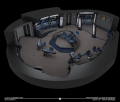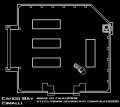Difference between revisions of "Vesta Class"
m |
m |
||
| Line 6: | Line 6: | ||
| image = Vesta.png | | image = Vesta.png | ||
| image3 = vestaclass1.jpg | | image3 = vestaclass1.jpg | ||
| − | | image4 = | + | | image4 = vesta_schematic.png |
| class = Vesta Class Explorer | | class = Vesta Class Explorer | ||
| specifications = | | specifications = | ||
}} | }} | ||
| − | The | + | The Vesta-class is currently the fastest ship in Starfleet, and serves as a bleeding-edge technological testbed for some of the most advanced spaceborne systems ever developed. Rare and extremely prized by their captains, these ships are reserved almost solely for prestigious exploratory missions and are rarely seen in the Federation’s core. |
| − | == History == | + | ===Class History=== |
| − | |||
| − | The | + | The Vesta-class starship development began with the return of the starship Voyager in 2378, with the goal of using the advances that ship had discovered to create a new, purpose-built explorer that could break all previous speed records. The long-term goal was to develop a vessel capable of implementing the failed slipstream drive project started by Seven of Nine and B’Elanna Torres during Voyager’s journey home, though the engineering requirements for this were still well beyond what Starfleet was capable of in the late 2370s. |
| − | The | + | The design process continued apace, though resources were diverted to other projects in the mid-2380s during the Federation’s attempted evacuation of Romulus, so it wasn’t until 2393 that the Vesta finally left spacedock. Following a year-long shakedown operation close to home, she was sent on her first long-range mission while her sisters were under construction. Performance was rated extremely highly, but the maintenance demands meant that this class could never be built in large numbers, so as of 2402 they remain a rare and highly advanced vessel in Starfleet. |
| + | ===Shipboard Life=== | ||
| − | + | Assignment to a Vesta-class ship is something highly sought by ambitious officers, as it is only granted to the absolute best in every area. While their missions might be shorter, these ships are sent to areas which Starfleet is interested in examining quickly and effectively with little external support, so they have to be prepared for anything. As such, this leads to a sense among Vesta crews that they are elite units, leading to both positive displays of comradeship as well as sometimes exclusionary and cliquish practices which make it difficult for new crewmembers to integrate, especially if a crew has already been deployed in the field. | |
| − | + | Recreational facilities aboard a Vesta are quite comprehensive, though the ship’s size and shape keep her from having quite the luxury of a Galaxy or Odyssey-class ship. Holodecks, holosuites, and recreational lounges are plentiful and most crew members have their own quarters. | |
| − | + | Department head roles aboard this class are often seen as direct stepping stones towards the command track on other explorers, with a tour on one of these ships being enough to catapult many officers up to executive officer positions. On that token, however, these assignments are so popular that crews will often stay together for many years. | |
| − | ==Internal Layout== | + | ===Internal Layout=== |
| − | ===Deck One=== | + | ====Deck One==== |
<gallery> | <gallery> | ||
| Line 35: | Line 35: | ||
</gallery> | </gallery> | ||
| − | ===Crew Areas=== | + | ====Crew Areas==== |
<gallery> | <gallery> | ||
| Line 46: | Line 46: | ||
</gallery> | </gallery> | ||
| − | ===Operational Areas=== | + | ====Operational Areas==== |
<gallery> | <gallery> | ||
| Line 56: | Line 56: | ||
</gallery> | </gallery> | ||
| − | == Vessels == | + | === Vessels of Note=== |
{| class="wikitable" | {| class="wikitable" | ||
!Name !! Registry !! Launched !! Status | !Name !! Registry !! Launched !! Status | ||
| − | |||
| − | |||
|- | |- | ||
|[[USS Artemis, EX-11000|USS ''Artemis'']] || [[USS Artemis, EX-11000|EX-11000]] || 21903.01 || Active | |[[USS Artemis, EX-11000|USS ''Artemis'']] || [[USS Artemis, EX-11000|EX-11000]] || 21903.01 || Active | ||
| − | |||
| − | |||
| − | |||
| − | |||
| − | |||
| − | |||
| − | |||
| − | |||
| − | |||
| − | |||
|} | |} | ||
[[Category: Starship]][[Category: Engineering]] | [[Category: Starship]][[Category: Engineering]] | ||
Revision as of 20:32, 8 October 2022
| STARSHIP | |
|---|---|
 | |
| Class | Vesta Class Explorer |
| Allegiance | United Federation of Planets |
 | |
| Specifications | |
| Type: | Explorer |
| Length: | 670 Meters |
| Beam: | 195 Meters |
| Height: | 88 Meters |
| Mass: | 3,321,630 metric tons |
| Decks: | 19 Deck Plans |
| Crew Compliment: | Standard: 115 Officers, 485 Enlisted Crew Breakdown Emergency: 2,000 |
| Warp Speed: | Type: Cruise Speed: Warp 8 Sustainable Speed: Warp 9.8 Emergency Speed: Warp 9.99 (36 hour automatic shutdown) |
| Impulse Engines: | Type: 2 Class 8 Main Impulse Engines (MIE), 2 Secondary Impulse Engines (SIE) Speed: .87 C |
| Other Propulsion Systems: | Rigel Labs X04 Quantum Slipstream Generator Speed: Warp 9.99998477 (12 hour automatic shutdown) |
| Defensive Systems: | Type-1A Shield generator |
| Other Defensive Systems: | Sensor Cloak, 20cm Ablative Armour |
| Armament: | Phasers: 2x Type XII Phaser Cannons (Saucer - Forward); 2x 140-degree Type-XII Arrays, one starboard, one port (Saucer - Dorsal); 2x 90-degree Type-XII Arrays, one starboard, one port (Saucer - Ventral); |
| Other Capabilities: | Planet Landing Capabilities - Blue Alert |
| Computer System: | Yori-Moto D4D019 |
| Tractor/Repulsor: | 2 Main Tractor/Repulsor Beams, 5 Shuttle Docking Tractors (4 in Main Bay, 1 for Yacht), 6 Docking Tractors |
| Shuttlecraft: | 1 Bay (A), 10 Shuttles (4 Type 12, 4 Type 14, 2 Type 17), 2 Runabouts (Delta Class) |
| Sensors: | SS Sierra 1a8 Deep Space Scientific Sensors Daystrom Industries HSCS-3SC-A Starship Sensors |
The Vesta-class is currently the fastest ship in Starfleet, and serves as a bleeding-edge technological testbed for some of the most advanced spaceborne systems ever developed. Rare and extremely prized by their captains, these ships are reserved almost solely for prestigious exploratory missions and are rarely seen in the Federation’s core.
Contents
Class History
The Vesta-class starship development began with the return of the starship Voyager in 2378, with the goal of using the advances that ship had discovered to create a new, purpose-built explorer that could break all previous speed records. The long-term goal was to develop a vessel capable of implementing the failed slipstream drive project started by Seven of Nine and B’Elanna Torres during Voyager’s journey home, though the engineering requirements for this were still well beyond what Starfleet was capable of in the late 2370s.
The design process continued apace, though resources were diverted to other projects in the mid-2380s during the Federation’s attempted evacuation of Romulus, so it wasn’t until 2393 that the Vesta finally left spacedock. Following a year-long shakedown operation close to home, she was sent on her first long-range mission while her sisters were under construction. Performance was rated extremely highly, but the maintenance demands meant that this class could never be built in large numbers, so as of 2402 they remain a rare and highly advanced vessel in Starfleet.
Shipboard Life
Assignment to a Vesta-class ship is something highly sought by ambitious officers, as it is only granted to the absolute best in every area. While their missions might be shorter, these ships are sent to areas which Starfleet is interested in examining quickly and effectively with little external support, so they have to be prepared for anything. As such, this leads to a sense among Vesta crews that they are elite units, leading to both positive displays of comradeship as well as sometimes exclusionary and cliquish practices which make it difficult for new crewmembers to integrate, especially if a crew has already been deployed in the field.
Recreational facilities aboard a Vesta are quite comprehensive, though the ship’s size and shape keep her from having quite the luxury of a Galaxy or Odyssey-class ship. Holodecks, holosuites, and recreational lounges are plentiful and most crew members have their own quarters.
Department head roles aboard this class are often seen as direct stepping stones towards the command track on other explorers, with a tour on one of these ships being enough to catapult many officers up to executive officer positions. On that token, however, these assignments are so popular that crews will often stay together for many years.
Internal Layout
Deck One
Crew Areas
Operational Areas
Vessels of Note
| Name | Registry | Launched | Status |
|---|---|---|---|
| USS Artemis | EX-11000 | 21903.01 | Active |











